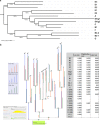Mash-based analyses of Escherichia coli genomes reveal 14 distinct phylogroups
- PMID: 33500552
- PMCID: PMC7838162
- DOI: 10.1038/s42003-020-01626-5
Mash-based analyses of Escherichia coli genomes reveal 14 distinct phylogroups
Abstract
In this study, more than one hundred thousand Escherichia coli and Shigella genomes were examined and classified. This is, to our knowledge, the largest E. coli genome dataset analyzed to date. A Mash-based analysis of a cleaned set of 10,667 E. coli genomes from GenBank revealed 14 distinct phylogroups. A representative genome or medoid identified for each phylogroup was used as a proxy to classify 95,525 unassembled genomes from the Sequence Read Archive (SRA). We find that most of the sequenced E. coli genomes belong to four phylogroups (A, C, B1 and E2(O157)). Authenticity of the 14 phylogroups is supported by several different lines of evidence: phylogroup-specific core genes, a phylogenetic tree constructed with 2613 single copy core genes, and differences in the rates of gene gain/loss/duplication. The methodology used in this work is able to reproduce known phylogroups, as well as to identify previously uncharacterized phylogroups in E. coli species.
Conflict of interest statement
The authors declare no competing interests.
Figures




References
-
- Alm, E. W., Walk, S. T. & Gordon, D. M. in Population Genetics of Bacteria. 69–89, 10.1128/9781555817114.ch6 (Wiley, 2011).
Publication types
MeSH terms
Substances
Grants and funding
LinkOut - more resources
Full Text Sources
Other Literature Sources

